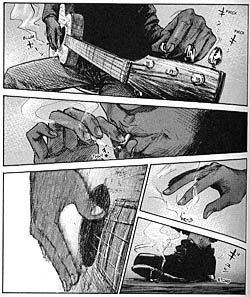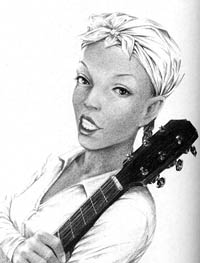 By Akira Hiramoto
By Akira Hiramoto
544 pages, black and white
Published by Del Rey
Robert Johnson was probably one of the greatest blues musicians of all time, his skills like no other and his influence continuing to musicians today. For that alone, I was interested in reading Akira Hiramoto’s Me and the Devil Blues, his story of the life of this amazing artist. What I probably should have done before I started reading the book, though, was pay a little more attention to the back cover copy. Had I looked at that a little more closely, maybe then I wouldn’t have been quite so surprised by its contents.
 It’s 1929 in the heart of Mississippi, and Robert “RJ” Johnson dreams of becoming a bluesman. His attempts to play guitar are laughable at best, as he struggles to understand what really makes the blues. Then he hears an old wives’s tale that if you stand in the center of a crossroads and pledge your soul to the devil, he will teach you how to play the blues. For some people, that would be the end of their story, but for RJ, it’s just the beginning.
It’s 1929 in the heart of Mississippi, and Robert “RJ” Johnson dreams of becoming a bluesman. His attempts to play guitar are laughable at best, as he struggles to understand what really makes the blues. Then he hears an old wives’s tale that if you stand in the center of a crossroads and pledge your soul to the devil, he will teach you how to play the blues. For some people, that would be the end of their story, but for RJ, it’s just the beginning.
At first, Me and the Devil Blues seems like an ordinary re-telling of the life of Robert Johnson, with Akira Hiramoto adding in the idea that all of Johnson’s claims to have sold his soul to the devil in fact being real. It’s a simple enough change to the story of his life, and I’d figured that would be the only change. As the back cover copy notes, though, Me and the Devil Blues is “a phantasmagoric re-imagining of the life of […] Robert Johnson” and as such that’s not the only thing to go a little off the rails from established history. I’m pretty sure, for instance, that Johnson never hung out with famous gangster Clyde Barrow. And I’m nothing short of positive that he never found himself with ten fingers on his right hand so that he could play the guitar even more adeptly than before.
 Are these good or bad additions? Well, for those who aren’t expecting Me and the Devil Blues to be an out-and-out fiction (instead of a close biography), it can be a little jarring. I know that I stared at the page for several minutes with a silly, startled expression on my face when I first got to these big, sweeping changes. But if you approach Me and the Devil Blues as something with no real connection to our own history, well, it’s not bad. There are some places where the book meanders a bit, and the last quarter of this book irritatingly barely features RJ at all. But there’s a certain level of entertainment seeing RJ and Clyde running around together (although I suspect you, like myself, will be counting the seconds until there’s a mention of Clyde’s fellow gangster and lover Bonnie Parker), and considering that the more-grounded-in-history portions of the first half of the book run more than a little slow and plodding, this faster pace in the second half ultimately acquits itself as the more interesting and enjoyable section of Me and the Devil Blues.
Are these good or bad additions? Well, for those who aren’t expecting Me and the Devil Blues to be an out-and-out fiction (instead of a close biography), it can be a little jarring. I know that I stared at the page for several minutes with a silly, startled expression on my face when I first got to these big, sweeping changes. But if you approach Me and the Devil Blues as something with no real connection to our own history, well, it’s not bad. There are some places where the book meanders a bit, and the last quarter of this book irritatingly barely features RJ at all. But there’s a certain level of entertainment seeing RJ and Clyde running around together (although I suspect you, like myself, will be counting the seconds until there’s a mention of Clyde’s fellow gangster and lover Bonnie Parker), and considering that the more-grounded-in-history portions of the first half of the book run more than a little slow and plodding, this faster pace in the second half ultimately acquits itself as the more interesting and enjoyable section of Me and the Devil Blues.
Amusingly enough, while Hiramoto’s writing works best when it’s the brasher, more action-oriented part of Me and the Devil Blues, his art is at its finest when he’s drawing the quieter moments of the story. Me and the Devil Blues looks nothing short of beautiful when Hiramoto draws portraits of his characters, especially RJ playing the guitar. There’s an early scene of RJ tuning his guitar and preparing to play that is perfectly composed, the viewpoint of the reader zooming in on specific elements like RJ adjusting the pegs, or taking a final drag off a cigarette. It’s very cinematic in its approach, and it works perfectly. Likewise, the portraits of the supporting cast are soft in their composure, coming across almost like an old faded photograph, but with such care and attention to detail that they’re some of the best pieces of art in the book. The more lively, active portions of the book aren’t bad, but they just can’t compare. Maybe it’s because there’s more going on those pages that Hiramoto just doesn’t devote the same amount of time to each character, but the difference is hard to not see.
Me and the Devil Blues is a strange book, starting off as a standard biography and then wildly veering off into a different direction. It’s enjoyable, but at the same time I can’t help but think that it’s also not terribly memorable. At its best, Me and the Devil Blues is an entertaining diversion. It was certainly worth my time as a reader, but with that in mind I suspect I’ll pass it along to someone else now that I’m done.
Purchase Links: Amazon.com
